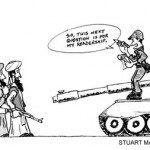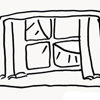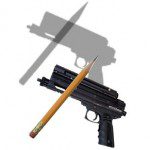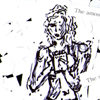Pictures at an execution
When secretly shot footage of Saddam Hussein's hanging leaked online, news outlets found themselves with gruesome choices to make.
On a former military base in north Baghdad in the early hours of December 30, 2006, masked hangmen prepared to execute Saddam Hussein. The ex-Iraqi dictator was sharply dressed, his hair neatly parted to one side. He declined a hood so they wrapped the cloth around his neck instead. Two of the men led their captive to the gallows and slipped a heavy rope noose over his head.
There, the official government video, shot without sound, ended. But, from amongst the spectators, a man continued recording the event with his cellphone, capturing the guards’ taunts, the crashing of the trap door, and Hussein’s corpse swinging at the end of the rope. Soon after the official video was released, the phone footage leaked.
Saddam’s execution brought with it a certain front-page lead, a series of ethical dilemmas and a wide range of reactions.The Edmonton Journal declined to print images of the hanging at all. The St. John’sTelegramprinted stills, but none with the noose in the shot. The Montreal Gazette blew up the noose still for its front page. When the cellphone video surfaced, editors were faced with an even tougher decision of what to do with the new, more graphic material. In Britain, the Guardian greeted the New Year with the gruesome image of Hussein’s hanging corpse on its front page. The phone footage was explicit, but it shed new light on to what had occurred – leaving journalists caught between taste and truth.
• • •
News that Hussein’s execution was impending had circulated since Christmas, and editors started discussing their visual options right away. It was 10 P.M. on Friday in Toronto when Hussein’s neck snapped, and when the silent, truncated official video appeared, most networks broadcast it on their Saturday newscasts. It wasn’t until later that evening that television editors and producers would find their judgments put to the test when Fox News became one of the first to link to the cellphone video of the hanging in its entirety on its website.
At this time, newspaper editors were still working with stills from the official video, which appeared in most major Canadian dailies that printed that Sunday – a sobering note amidst stories about New Year’s parties and end-of-year lists. Like many others, the Gazette went front with a page-wide photo of Hussein’s guards adjusting the noose around his neck. “It seemed like a very compelling, extremely strong news photograph,” says editor-in-chief Andrew Phillips. “Very graphic and disturbing to some people, but you know, it had huge news impact.”
The Gazette played the video still larger than most papers, but, says Phillips, there was no denying that it was the biggest news of the day. “It was bold,” he says. “If we didn’t publish on Sunday and it was on Monday, there would have been good reason to make it smaller.”
In Edmonton, the Journal took a different road: its front page showed not Hussein, but those who wanted him dead: a large group of Iraqi men cheering after the execution in Basra, beautiful blue sky behind them. In the centre, a young boy waved an Iraqi flag; next to him, a man thrust a rifle in the air. This image, says Journaldeputy editor Roy Wood, reflected the atmosphere in Iraq in a way that a still from a video couldn’t. “We don’t normally run pictures of people being killed, if we can avoid it,” Wood says. “It’s not appropriate. It’s not tasteful. It’s not responsible.”
Given the video’s undoubted newsworthiness, most editors felt the question wasn’t whether or not to publish them, but which images to use, where to place them and how big to make them. Faculty at the Poynter Institute discussed the topic and posted their thoughts online. “Placement,” Bob Steele, who teaches ethics at Poynter, said in the article, “is a balance of the ‘truth-telling’ principle that is the primary obligation of journalism and the principle of ‘minimizing harm.’” There were, he said, many stakeholders to consider: the dead man, his family, and the audience, some of whom might be offended by the graphic content.
These are questions news editors grapple with on a regular basis, and, as natural disasters and wars rage on, standards are changing. A couple of years ago, says Phillips, the Gazette would have never printed pictures of dead bodies. But with the ever-climbing death tolls of Iraq and Afghanistan, it’s hard to find a paper not yet bloodied. “It would be pretty hard to reflect the reality without having pictures like that,” says Phillips. “But we wouldn’t [print] it without debating it or discussing it.”
• • •
Tony Burman, editor-in-chief of CBC News, and his senior staff started weighing their coverage options for Hussein’s execution in December. The CBC knew it was coming, but it was unclear what kind of footage would be available. For a moment, it even seemed possible that the hanging would be televised live from Iraq. But all things considered, says Burman, “there was no real doubt in our mind that we would be, as we had been in the past, very restrained in our broadcast of this kind of video.”
The CBC decided that if footage of the actual moment of death became public, they would not broadcast it. “We have an intelligent audience that really doesn’t need to have gratuitous images forced on them for them to get the point,” says Burman. “Our preference was to broadcast and publish everything we can. We are not in the business to censor anything. We just felt that we could easily convey the essence of that story without that 20-second sequence.”
While the sequence wasn’t part of the state-released video, it did appear when the cellphone footage surfaced. This clip, with sound, captured the moments before and after the execution. As Hussein makes his way to the gallows his executioners taunt him: “go to hell.”
Fox News was the first to break the cellphone video Saturday night. Criticism of how the hanging was handled soon followed. “It was a different angle of what we had already seen,” explained David Rhodes, vice-president news at Fox News Channel, in a Reuters news report. “It was useful because there’s some audio on it that you didn’t necessarily hear in the previous version, and it’s a fuller picture as to what was happening. You can hear all the principals speaking.”
The clip appeared on the CBC’s Sunday newscast: the network translated the heated exchanges between Hussein and his guards but blacked out before the trap door opened. What was said, Burman feels, was an extremely important part of the story. “There was no hesitation on our part to broadcast that.”
Whether the video really added much context is debatable, says Mike Gasher, director of the Concordia University’s Department of Journalism. “I watched it a couple of times but it was so bad in terms of quality it was hard to know what was going on,” he says. “Is any journalistic purpose served by showing these images, especially when they were as rough as they were and the language was in Arabic and most of the Canadian audience wouldn’t understand?”
Many newspaper editors took a similar stance, citing the blurriness of the images as to why they were largely ignored in print. Others said anything not already seen before would be too gory to publish anyway.
The Globe and Mail did not print on Sunday. On New Year’s Day it used stills only from the state-released video. Brian Kerrigan works in the Globe’s photo department and discussed the cellphone images with colleagues when they arrived at the paper on January 3. Ultimately, they decided that the shots were not an option for the Globe. “You have to take into consideration your readership,” Kerrigan explains. “It’s one thing for folks like us who see this every day; it’s another for folks who see it on their breakfast table.”
The Globe’s photo department tracks daily the covers of major papers around the world and Kerrigan was shocked when he saw the Guardian’s huge, explicit front page picture on New Year’s Day. The shot drew feedback from over 200 readers. In a January 8 column, the Guardian’s readers’ editor, Ian Mayes, quoted the deputy editor on duty at the time of the video’s release as saying: “We had seen the controlled, manipulated and sanitised version of the event put out by the Iraqi government. This was the version they did not want us to see.”
Guardian editor Alan Rusbridger added: “It is a shocking image of a repellent act and we have used it unflinchingly. I believe you have a duty to show such repellent acts, especially when your government is involved in the process by which they came about. This event had been mischaracterised on the first day. If you look at the video, which I did before we published this picture, then you have an entirely different impression.”
Saddam Hussein was buried at 4 a.m. local time, New Year’s Eve near his birthplace in Tikrit, Iraq. About 100 people watched as his body was lowered into the ground. The following day, the Toronto Star, like many other papers, ran a photo of Iraqi grievers, heads bowed, crowded around the flag-draped grave: page A3.
Jennifer Fong was the Director of Publicity for the Summer 2007 issue of the Ryerson Review of Journalism.












































